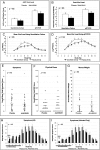A randomized, double-blind, placebo-controlled study of an RNAi-based therapy directed against respiratory syncytial virus
- PMID: 20421463
- PMCID: PMC2889365
- DOI: 10.1073/pnas.0912186107
A randomized, double-blind, placebo-controlled study of an RNAi-based therapy directed against respiratory syncytial virus
Abstract
RNA interference (RNAi) is a natural mechanism regulating protein expression that is mediated by small interfering RNAs (siRNA). Harnessing RNAi has potential to treat human disease; however, clinical evidence for the effectiveness of this therapeutic approach is lacking. ALN-RSV01 is an siRNA directed against the mRNA of the respiratory syncytial virus (RSV) nucleocapsid (N) protein and has substantial antiviral activity in a murine model of RSV infection. We tested the antiviral activity of ALN-RSV01 in adults experimentally infected with wild-type RSV. Eighty-eight healthy subjects were enrolled into a randomized, double-blind, placebo-controlled trial. A nasal spray of ALN-RSV01 or saline placebo was administered daily for 2 days before and for 3 days after RSV inoculation. RSV was measured serially in nasal washes using several different viral assays. Intranasal ALN-RSV01 was well tolerated, exhibiting a safety profile similar to saline placebo. The proportion of culture-defined RSV infections was 71.4 and 44.2% in placebo and ALN-RSV01 recipients, respectively (P = 0.009), representing a 38% decrease in the number of infected and a 95% increase in the number of uninfected subjects. The acquisition of infection over time was significantly lower in ALN-RSV01 recipients (P = 0.007 and P = 0.03, viral culture and PCR, respectively). Multiple logistic regression analysis showed that the ALN-RSV01 antiviral effect was independent of other factors, including preexisting RSV antibody and intranasal proinflammatory cytokine concentrations. ALN-RSV01 has significant antiviral activity against human RSV infection, thus establishing a unique proof-of-concept for an RNAi therapeutic in humans and providing the basis for further evaluation in naturally infected children and adults.
Conflict of interest statement
Conflict of interest statement: J.D. has received grants and contracts involving RSV research administered through the University of Tennessee from MedImmune, Astra Zeneca, ADMA Biologics, Tibotec, and Alnylam Pharmaceuticals. R.L.-W. is employed by Retroscreen, Ltd. (London, UK). T.W. receives research and salary support from Retroscreen Ltd. (London, UK). J.C., S.N., R.M., J.G., and A.V. are employees of Alnylam Pharmaceuticals.
Figures



References
-
- Fire A, et al. Potent and specific genetic interference by double-stranded RNA in Caenorhabditis elegans. Nature. 1998;391:806–811. - PubMed
-
- Elbashir SM, et al. Duplexes of 21-nucleotide RNAs mediate RNA interference in cultured mammalian cells. Nature. 2001;411:494–498. - PubMed
-
- Wianny F, Zernicka-Goetz M. Specific interference with gene function by double-stranded RNA in early mouse development. Nat Cell Biol. 2000;2:70–75. - PubMed
-
- Soutschek J, et al. Therapeutic silencing of an endogenous gene by systemic administration of modified siRNAs. Nature. 2004;432:173–178. - PubMed
-
- Zimmermann TS, et al. RNAi-mediated gene silencing in non-human primates. Nature. 2006;441:111–114. - PubMed
Publication types
MeSH terms
Substances
LinkOut - more resources
Full Text Sources
Other Literature Sources
Medical

